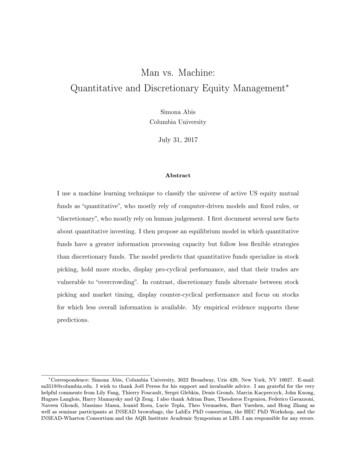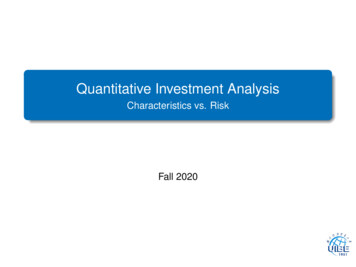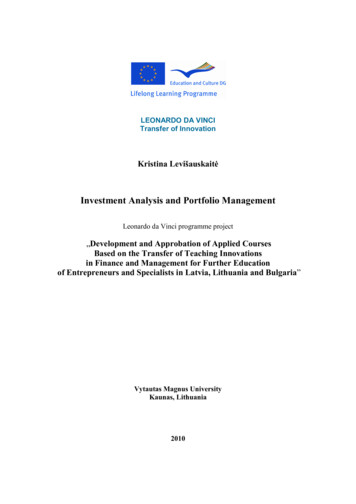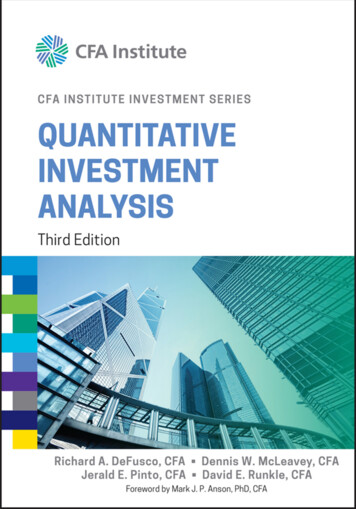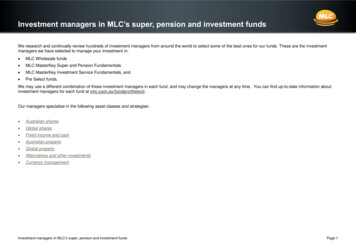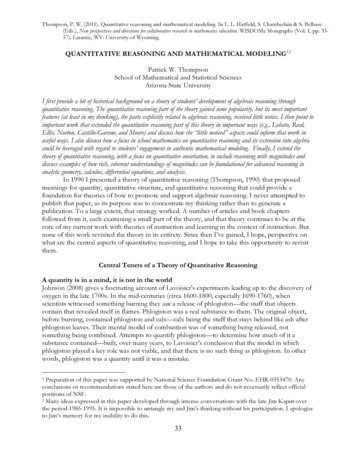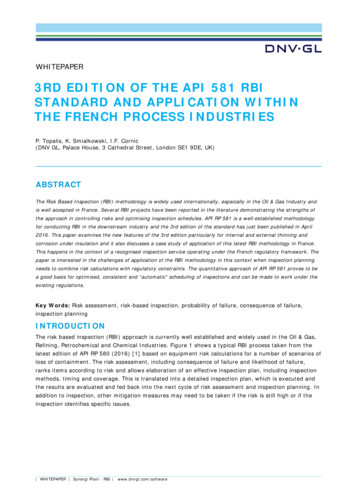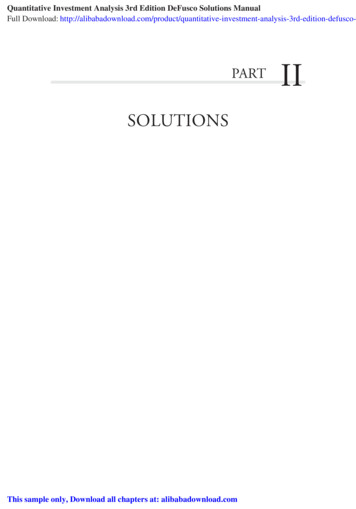
Transcription
Quantitative Investment Analysis 3rd Edition DeFusco Solutions ManualFull Download: SThis sample only, Download all chapters at: alibabadownload.comII
CHAPTER1THE TIME VALUE OF MONEYSOLUTIONS1. A. Investment 2 is identical to Investment 1 except that Investment 2 has low liquidity.The difference between the interest rate on Investment 2 and Investment 1 is 0.5 percentage point. This amount represents the liquidity premium, which represents compensation for the risk of loss relative to an investment’s fair value if the investment needsto be converted to cash quickly.B. To estimate the default risk premium, find the two investments that have the samematurity but different levels of default risk. Both Investments 4 and 5 have a maturityof eight years. Investment 5, however, has low liquidity and thus bears a liquidity premium. The difference between the interest rates of Investments 5 and 4 is 2.5 percentage points. The liquidity premium is 0.5 percentage point (from Part A). This leaves2.5 0.5 2.0 percentage points that must represent a default risk premium reflectingInvestment 5’s high default risk.C. Investment 3 has liquidity risk and default risk comparable to Investment 2, but withits longer time to maturity, Investment 3 should have a higher maturity premium. Theinterest rate on Investment 3, r3, should thus be above 2.5 percent (the interest rate onInvestment 2). If the liquidity of Investment 3 were high, Investment 3 would matchInvestment 4 except for Investment 3’s shorter maturity. We would then concludethat Investment 3’s interest rate should be less than the interest rate on Investment 4,which is 4 percent. In contrast to Investment 4, however, Investment 3 has low liquidity. It is possible that the interest rate on Investment 3 exceeds that of Investment 4despite 3’s shorter maturity, depending on the relative size of the liquidity and maturity premiums. However, we expect r3 to be less than 4.5 percent, the expected interestrate on Investment 4 if it had low liquidity. Thus 2.5 percent r3 4.5 percent.2. i. Draw a time line.0 250,000127Xii. Identify the problem as the future value of a lump sum.85
86Solutionsiii. Use the formula for the future value of a lump sum.PV 0.05 5,000,000 250,000FVN PV (1 r )N 250,000 (1.03)7 307,468.477210 307,468.47FV 250,000PVThe future value in seven years of 250,000 received today is 307,468.47 if theinterest rate is 3 percent compounded annually.3. i. Draw a time line.21010X 500,000PVFVii. Identify the problem as the future value of a lump sum.iii. Use the formula for the future value of a lump sum.FVN PV (1 r )N 500,000 (1.07 )10 983,575.6810210 983,575.68FV 500,000PVYour client will have 983,575.68 in 10 years if she invests 500,000 today andearns 7 percent annually.4. A. To solve this problem, take the following steps:i. Draw a time line and recognize that a year consists of four quarterly periods.0 100,000PV1234XFVii. Recognize the problem as the future value of a lump sum with quarterly compounding.
Chapter 187The Time Value of Money iii. Use the formula for the future value of a lump sum with periodic compounding,where m is the frequency of compounding within a year and N is the number ofyears.r mN FVN PV 1 s m 0.07 100,000 1 4 4(1) 107,185.9010324 107,185.90FV 100,000PViv. As an alternative to Step iii, use a financial calculator. Most of the equations inthis reading can be solved using a financial calculator. Calculators vary in theexact keystrokes required (see your calculator’s manual for the appropriate keystrokes), but the following table illustrates the basic variables and algorithms.Remember, however, that a financial calculator is only a shortcut way of performing the mechanics and is not a substitute for setting up the problem or knowingwhich equation is appropriate.Time Value of Money VariableNotation Used onMost CalculatorsNumerical Valuefor This ProblemNumber of periods or paymentsN4Interest rate per period%i7/4Present valuePV 100,000Future valueFV computeXPayment sizePMTn/a ( 0)In summary, your client will have 107,185.90 in one year if he deposits 100,000 today in a bank account paying a stated interest rate of 7 percent compounded quarterly.B. To solve this problem, take the following steps:i. Draw a time line and recognize that with monthly compounding, we need toexpress all values in monthly terms. Therefore, we have 12 periods.0 100,000PV1212XFVii. Recognize the problem as the future value of a lump sum with monthly compounding.
88Solutionsiii. Use the formula for the future value of a lump sum with periodic compounding,where m is the frequency of compounding within a year and N is the number ofyears.r FVN PV 1 s m mN 0.07 100,000 1 12 12(1) 107,229.0112210 107,229.01FV 100,000PViv. As an alternative to Step iii, use a financial calculator.Notation Used on Most CalculatorsNumerical Value for This ProblemN12%i7/12PV 100,000FV computeXPMTn/a ( 0)Using your calculator’s financial functions, verify that the future value, X,equals 107,229.01.In summary, your client will have 107,229.01 at the end of one year if hedeposits 100,000 today in his bank account paying a stated interest rate of 7percent compounded monthly.C. To solve this problem, take the following steps:i. Draw a time line and recognize that with continuous compounding, we need touse the formula for the future value with continuous compounding.01 100,000PVXFVii. Use the formula for the future value with continuous compounding (N is thenumber of years in the expression).FVN PVe r Ns 100,000e 0.07(1) 107,250.82The notation e0.07(1) is the exponential function, where e is a number approximately equal to 2.718282. On most calculators, this function is on thekey marked ex. First calculate the value of X. In this problem, X is 0.07(1) 0.07.
Chapter 189The Time Value of Money Key 0.07 into the calculator. Next press the ex key. You should get 1.072508. Ifyou cannot get this figure, check your calculator’s manual.01 100,000PV 107,250.82FVIn summary, your client will have 107,250.82 at the end of one year ifhe deposits 100,000 today in his bank account paying a stated interest rate of7 percent compounded continuously.5. Stated annual interest rate 5.89 percent.Effective annual rate on bank deposits 6.05 percent.Stated interest rate 1 EAR 1 m 0.0589 1.0605 1 m mmFor annual compounding, with m 1, 1.0605 1.0589.For quarterly compounding, with m 4, 1.0605 1.060214.For monthly compounding, with m 12, 1.0605 1.060516.Hence, the bank uses monthly compounding.6. A. Use the formula for the effective annual rate.Effective annual rate (1 Periodic interest rate)m 1 0.08 1 4 4(1) 1 0.0824 or 8.24%B. Use the formula for the effective annual rate.Effective annual rate (1 Periodic interest rate)m 1 0.08 1 12 12(1) 1 0.0830 or 8.30%C. Use the formula for the effective annual rate with continuous compounding.Effective annual rate e r 1se0.08 – 1 0.0833 or 8.33%7. i. Draw a time line.012 20,000 20,0001920 20,000 20,000X FVii. Identify the problem as the future value of an annuity.
90Solutionsiii. Use the formula for the future value of an annuity. (1 r )N 1 FVN A r (1 0.07 )20 1 20,000 0.07 819,909.850119220 20,000 20,000 20,000 20,000FV 819,909.85iv. Alternatively, use a financial calculator.Notation Used on Most CalculatorsNumerical Value for This ProblemN20%i7PVn/a ( 0)FV computeXPMT8. 20,000Enter 20 for N, the number of periods. Enter 7 for the interest rate and 20,000for the payment size. The present value is not needed, so enter 0. Calculate the futurevalue. Verify that you get 819,909.85 to make sure you have mastered your calculator’s keystrokes.In summary, if the couple sets aside 20,000 each year (starting next year), theywill have 819,909.85 in 20 years if they earn 7 percent annually.i. Draw a time line.0123 20,000 20,0004 20,00056X FVii. Recognize the problem as the future value of a delayed annuity. Delaying the payments requires two calculations.iii. Use the formula for the future value of an annuity (Equation 7) (1 r )N 1 FVN A r
Chapter 191The Time Value of Money to bring the three 20,000 payments to an equivalent lump sum of 65,562.00 fouryears from today.Notation Used on Most CalculatorsNumerical Value for This ProblemN3%i9PVn/a ( 0)FV computeXPMT 20,000iv. Use the formula for the future value of a lump sum (Equation 2), FVN PV(1 r)N,to bring the single lump sum of 65,562.00 to an equivalent lump sum of 77,894.21six years from today.Notation Used on Most CalculatorsNumerical Value for This ProblemN2%i9PV 65,562.00FV computeXPMTn/a ( 0)023 20,000 20,0001456XFV 20,000 77,894.21FV6 65,562.00FV49.In summary, your client will have 77,894.21 in six years if she receives threeyearly payments of 20,000 starting in Year 2 and can earn 9 percent annually on herinvestments.i. Draw a time line.0123X45 75,000FVPVii. Identify the problem as the present value of a lump sum.iii. Use the formula for the present value of a lump sum.PV FVN (1 r ) N 75,000 (1 0.06 ) 5 56,044.36
92Solutions432105 75,000FV 56,044.36PVIn summary, the father will need to invest 56,044.36 today in order to have 75,000 in five years if his investments earn 6 percent annually.10. i. Draw a time line and recognize that a year consists of four quarterly periods.01234100,000XPVFVii. Recognize the problem as the present value of a lump sum with quarterly compounding.iii. Use the formula for the present value of a lump sum with periodic compounding,where m is the frequency of compounding within a year and N is the number ofyears.r PV FVN 1 s m mN 0.07 100,000 1 4 4(1) 93,295.8502134100,00093,295.85PVFViv. Alternatively, use a financial calculator.Notation Used on Most CalculatorsNumerical Value for This ProblemN4%i7/4PV computeXFV 100,000PMTn/a ( 0)Use your calculator’s financial functions to verify that the present value, X, equals 93,295.85.In summary, your client will have to deposit 93,295.85 today to have 100,000 inone year if her bank account pays 7 percent compounded quarterly.11. i. Draw a time line for the 10 annual payments.012910XPV 100,000 100,000 100,000 100,000
Chapter 193The Time Value of Money ii. Identify the problem as the present value of an annuity.iii. Use the formula for the present value of an annuity.1 1 (1 r )NPV A r 1 1 (1 0.05)10 100,000 0.05 772,173.490X 12910 100,000 100,000 100,000 100,000PV 772,173.49iv. Alternatively, use a financial calculator.Notation Used on Most CalculatorsNumerical Value for This ProblemN10%i5PV computeXFVn/a ( 0)PMT 100,000In summary, the present value of 10 payments of 100,000 is 772,173.49 if thefirst payment is received in one year and the rate is 5 percent compounded annually.Your client should accept no less than this amount for his lump sum payment.12. i. Draw a time line.0PV1 1,0002 1,000ii. Recognize the problem as the present value of a perpetuity.iii. Use the formula for the present value of a perpetuity. A 1,000 33,333.33PV r 0.03 01 1,0002 1,000PV 33,333.33The investor will have to pay 33,333.33 today to receive 1,000 per quarterforever if his required rate of return is 3 percent per quarter (12 percent per year).
94Solutions13. i. Draw a time line to compare the lump sum and the annuity.01220500,0000050,000050,000050,000ii. Recognize that we have to compare the present values of a lump sum and an annuity.iii. Use the formula for the present value of an annuity (Equation 11).1 1 (1.06 )20PV 50,000 0.06 573,496 Notation Used on Most CalculatorsNumerical Value for This ProblemN20%i6PV computeXFVn/a ( 0)PMT n 11The annuity plan is better by 73,496 in present value terms ( 573,496 500,000).14. A. To evaluate the first instrument, take the following steps:i. Draw a time line.01324 20,0001 1 (1 r )Nii. PV3 A r 20,00076 20,000 20,000 1 1 (1 0.08)4 20,000 0.08 66,242.54iii. PV0 5 PV3 66,242.54 52,585.46N 1.083(1 r )You should be willing to pay 52,585.46 for this instrument.
Chapter 195The Time Value of Money B. To evaluate the second instrument, take the following steps:i. Draw a time line.1234 20,000 20,000 20,000 20,000 10,000 30,0000The time line shows that this instrument can be analyzed as an ordinaryannuity of 20,000 with four payments (valued in Step ii below) and a 10,000payment to be received at t 4 (valued in Step iii below).1 1 (1 r )Nii. PV A r 1 1 (1 0.08)4 20,000 0.08 66,242.54iii. PV FV4(1 r )N 10,000(1 0.08)4 7,350.30iv. Total 66,242.54 7,350.30 73,592.84You should be willing to pay 73,592.84 for this instrument.15. i. Draw a time line.012XPV34 10,000 10,00056 10,000 10,000ii. Recognize the problem as a delayed annuity. Delaying the payments requires twocalculations.iii. Use the formula for the present value of an annuity (Equation 11)1 1 (1 r )NPV A r to bring the four payments of 10,000 back to a single equivalent lump sum of 33,121.27 at t 2. Note that we use t 2 because the first annuity payment is thenone period away, giving an ordinary annuity.Notation Used on Most CalculatorsNumerical Value for This ProblemN4%i8PV computePMTX 10,000
96Solutionsiv. Then use the formula for the present value of a lump sum (Equation 8), PV FVN(1 r) N, to bring back the single payment of 33,121.27 (at t 2) to an equivalentsingle payment of 28,396.15 (at t 0).Notation Used on Most CalculatorsNumerical Value for This ProblemN2%i8PV computeXFV 33,121.27PMTn/a ( 0)0321XPV 10,000 28,396.15Equation 8456 10,000 10,000 10,000 33,121.27Equation 11In summary, you should set aside 28,396.15 today to cover four payments of 10,000 starting in three years if your investments earn a rate of 8 percent annually.16. i. Draw a time line.01212 1,061.68FV 1,000PVii. Recognize the problem as the future value of a lump sum with monthly compounding.iii. Use the formula for the future value of a lump sum with periodic compoundingFVN PV[1 (rs/m)]mNand solve for rs, the stated annual interest rate: 1,061.68 1,000[1 (rs/12)]12(1) so rs 0.06iv. Alternatively, use a financial calculator to solve for r.Notation Used on Most CalculatorsNumerical Value for This ProblemN12%icomputeXPV 1,000FV 1,061.68PMTn/a ( 0)Use your calculator’s financial functions to verify that the stated interest rate ofthe savings account is 6 percent with monthly compounding.
Chapter 197The Time Value of Money 17. i. Draw a time line.012X35,000PV100,000FVii. Recognize the problem as the future value of a lump sum with monthly compounding.iii. Use the formula for the future value of a lump sum, FVN PV[1 (rs/m)]mN, wherem is the frequency of compounding within a year and N is the number of years. Solvefor mN, the number of months. 100,000 35,000[1 (0.05/12)]12N so 12N 252.48 monthsiv. Alternatively, use a financial calculator.Notation Used on Most CalculatorsNumerical Value for This ProblemNcomputeX%i5/12PV 35,000FV 100,000PMTn/a ( 0)Use your calculator’s financial functions to verify that your client will have towait 252.48 months to have 100,000 if he deposits 35,000 today in a bank accountpaying 5 percent compounded monthly. (Some calculators will give 253 months.)18. i. Draw a time line.012171819(X )(X )(X ) 20,000 20,00020 20,00021 20,000ii. Recognize that you need to equate the values of two annuities.iii. Equate the value of the four 20,000 payments to a single payment in Period 17 using the formula for the present value of an annuity (Equation 11), with r 0.05. Thepresent value of the college costs as of t 17 is 70,919. 1 1 (1.05)4PV 20,000 0.05Notation Used on Most Calculators 70,919 Numerical Value for This ProblemN4%i5PV computeXFVn/a ( 0)PMT 20,000
98Solutionsiv. Equate the value of the 17 investments of X to the amount calculated in Step iii, collegecosts as of t 17, using the formula for the future value of an annuity (Equation 7).Then solve for X. (1.05)17 1 70,919 25.840366 X 0.05 X 2,744.50Notation Used on Most CalculatorsNumerical Value for This ProblemN17%i5PVn/a ( 0)FV 70,919PMT compute0X12171819(X )(X )(X ) 20,000 20,000 70,919Equation 72021 20,000 20,000Equation 1125.8404X 70,919In summary, your client will have to save 2,744.50 each year if she starts nextyear and makes 17 payments into a savings account paying 5 percent annually.19. i. Draw a time line.012C 7,000171819Year 1paymentYear 2payment2021Year 3paymentYear 4paymentii. Recognize that the payments in Years 18, 19, 20, and 21 are the future values of alump sum of C 7,000 in Year 0.iii. With r 5%, use the formula for the future value of a lump sum (Equation 2), FVN PV (1 r)N, four times to find the payments. These future values are shown on thetime line below.012C 7,0001718Year 1paymentEquation 219Year 2payment20Year 3payment21Year 4paymentC 16,846C 17,689C 18,573C 19,502
Quantitative Investment Analysis 3rd Edition DeFusco Solutions ManualFull Download: vestment-analysis-3rd-edition-defusco-sChapter 199The Time Value of Money iv. Using the formula for the present value of a lump sum (r 6%), equate the four collegepayments to single payments as of t 17 and add them together. C 16,846(1.06) 1 C 17,689(1.06) 2 C 18,573(1.06) 3 C 19,502(1.06) 4 C 62,677v. Equate the sum of C 62,677 at t 17 to the 17 payments of X, using the formula forthe future value of an annuity (Equation 7). Then solve for X. (1.06 )17 1 C 62,677 X 28.21288 X 0.06 X C 2,221.58Notation Used on Most CalculatorsNumerical Value for This ProblemN17%i6PVn/a ( 0)FVC 62,677PMT compute0X1217(X )(X )(X )1819202128.21288X C 62,677Equation 7In summary, the couple will need to put aside C 2,221.58 each year if they startnext year and make 17 equal payments.20. To compute the compound growth rate, we only need the beginning and ending EPSvalues of 4.00 and 7.00 respectively, and use the following equation:FVN PV (1 r )N7 4 (1 r )41 r ( 7 4)14r ( 7 4)14 1 0.1502 15.02%EPS grew at an annual rate of 15.02 percent during the four years.21. A is correct. Using the general time value of money formula, for sales, solve for r in theequation 2 1 (1 r)5. For income, solve 3 1 (1 r)5. Alternatively, using a financial calculator, for sales, enter N 5, PV 1, PMT 0, FV 2 and compute I/Y. Forincome, change the FV to 3 and again solve for I/Y. The solution for sales is 14.87%; andfor income is 24.57%.This sample only, Download all chapters at: alibabadownload.com
A. Investment 2 is identical to Investment 1 except that Investment 2 has low liquidity. The difference between the interest rate on Investment 2 and Investment 1 is 0.5 percent - age point. This amount represents the liquidity premium, which represents compen-sation for the risk

